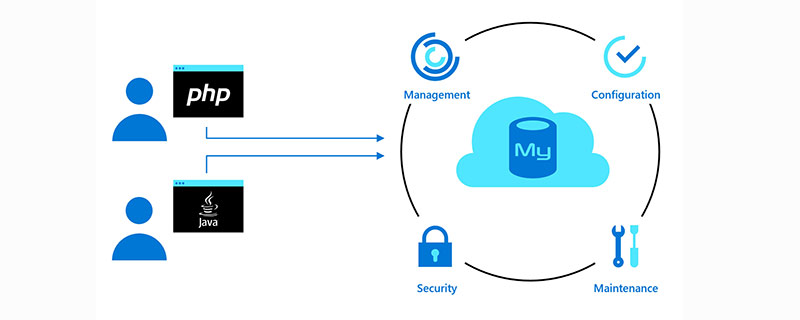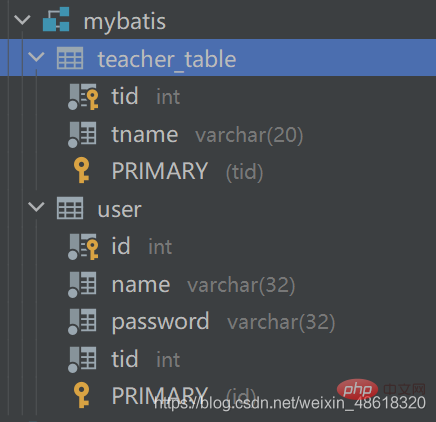Understand the basics of Mybatis

Free learning recommendation: mysql video tutorial
##mybatis
mybatis-config.xml detailed configuration (when configuring, you must delete the redundant attributes and cannot have Chinese characters, otherwise an error will be reported!)<?xml version="1.0" encoding="UTF-8" ?>nbsp;configuration
PUBLIC "-//mybatis.org//DTD Config 3.0//EN"
"http://mybatis.org/dtd/mybatis-3-config.dtd"><!--configuration核心配置 配置文件的根元素 --><configuration>
<!-- 属性:定义配置外在化 -->
<properties></properties>
<!-- 设置:定义mybatis的一些全局性设置 -->
<settings>
<!-- 具体的参数名和参数值 -->
<setting></setting>
</settings>
<!-- 类型名称:为一些类定义别名 -->
<typealiases>
<!-- 实体类少 建议 第一种取别名方式-->
<typealias></typealias>
<!--实体类多 建议 第二种取别名方式
默认情况下用这种方式 别名为类名 首字母最好小写
-->
<package></package>
</typealiases>
<!-- 类型处理器:定义Java类型与数据库中的数据类型之间的转换关系 -->
<typehandlers></typehandlers>
<!-- 对象工厂 -->
<objectfactory></objectfactory>
<!-- 插件:mybatis的插件,插件可以修改mybatis的内部运行规则 -->
<plugins>
<plugin></plugin>
</plugins>
<!-- 环境:配置mybatis的环境 -->
<environments>
<!-- 环境变量:可以配置多个环境变量,比如使用多数据源时,就需要配置多个环境变量 -->
<environment>
<!-- 事务管理器 -->
<transactionmanager></transactionmanager>
<!-- 数据源 配置连接我的数据库-->
<datasource>
<property></property>
<property></property>
<property></property>
<property></property>
</datasource>
</environment>
</environments>
<!-- 数据库厂商标识 -->
<databaseidprovider></databaseidprovider>
<!-- 映射器:指定映射文件或者映射类 -->
<mappers>
<mapper></mapper>
</mappers></configuration>Paging
Reduce the amount of data access limt implements paging
sql statement: select * from table name limt 0,5;
- 0: The starting position of the data
- 5: Data length
The first type: using Mybatis 1 interface
List<user> getUserByLimit(Map<string> map);</string></user>
<select>
select *
from mybatis.user
limit ${starIndex},${pageSize} </select><resultmap> <result></result> </resultmap>
@Test
public void getUserByLimitTest() {
SqlSession sqlSession = MyBatisUtils.getSqlSession ();
UserMapper mapper = sqlSession.getMapper (UserMapper.class);
HashMap hashMap = new HashMap<string> ();
hashMap.put ("starIndex", 1);
hashMap.put ("pageSize", 2);
List userByLimit = mapper.getUserByLimit (hashMap);
for (Object o : userByLimit) {
System.out.println (o);
}
sqlSession.close ();
}</string>Second: Use RowBounds method 1. Interface
List getUserList();
2. Implement the interface
<select> select * from mybatis.user </select>
/**
* 测试使用RowBounds实现分页
*/@Test
public void getUserByLimitRowBoundsTest() {
SqlSession sqlSession = MyBatisUtils.getSqlSession ();
RowBounds rowBounds = new RowBounds (0, 2);
List<user> userList = sqlSession.selectList ("com.kuang.w.dao.UserMapper.getUserList", null, rowBounds);
for (User user : userList) {
System.out.println (user);
}
//关闭
sqlSession.close ();
}</user>Third method: Use Mybatis’ paging plug-in pageHeIper
sql Many-to-one processing
Database:
pojo The teacher-table table in the database corresponds to the entity class Teacher
package com.kuang.w.pojo;
import lombok.Data;
/**
* @author W
*/
@Data
public class Teacher {
private int tId;
private String tName;
}package com.kuang.w.pojo;import lombok.Data;/**
* @author W
*/@Datapublic class Student {
private int id;
private int tid;
private String name;
private String password;
private Teacher teacher;}List<student> getStudentList();</student>
<!-- 多对一查询
1 子查询 mysql 通过一个表里是数据 与另一个表的一个数据相的情况下 查询另一个的数据 一起显示
-->
<select>
select *
from mybatis.user; </select>
<resultmap>
<!-- 复杂属性 对象用 :association 集合用:collection-->
<!--column 数据库中的字段 property 实体类中的属性-->
<result></result>
<result></result>
<result></result>
<!--javaType 一个 Java 类的全限定名
,或一个类型别名(关于内置的类型别名,可以参考上面的表格)。
如果你映射到一个 JavaBean,MyBatis 通常可以推断类型。
然而,如果你映射到的是 HashMap,
那么你应该明确地指定 javaType 来保证行为与期望的相一致。-->
<association></association>
</resultmap>
<select>
select *
from mybatis.teacher_table
where tid = #{id}; </select><!--2 多表联查--> <select> select u.id uid, u.name uname, u.password upassword, u.tid utid, t.tname from mybatis.user u, mybatis.teacher_table t where t.tid = u.tid; </select> <!-- 映射--> <resultmap> <result></result> <result></result> <result></result> <result></result> <association> <result></result> </association> </resultmap>
<?xml version="1.0" encoding="UTF8" ?>nbsp;configuration
PUBLIC "-//mybatis.org//DTD Config 3.0//EN"
"http://mybatis.org/dtd/mybatis-3-config.dtd"><configuration>
<properties></properties>
<settings>
<setting></setting>
</settings>
<typealiases>
<typealias></typealias>
<typealias></typealias>
</typealiases>
<environments>
<environment>
<transactionmanager></transactionmanager>
<datasource>
<property></property>
<property></property>
<property></property>
<property></property>
</datasource>
</environment>
</environments>
<mappers>
<!-- <mapper resource="com/kuang/w/dao/TeacherMapper.xml"></mapper>
<mapper resource="com/kuang/w/dao/StudentMapper.xml"></mapper>-->
<mapper></mapper>
<mapper></mapper>
</mappers></configuration> @Test
public void getStudentListTest() {
SqlSession sqlSession = MyBatisUtils.getSqlSession ();
StudentMapper mapper = sqlSession.getMapper (StudentMapper.class);
List<student> studentList = mapper.getStudentList ();
for (Student student : studentList) {
System.out.println (student);
}
sqlSession.commit ();
sqlSession.close ();
}</student>sql one-to-many processing
The entity class corresponding to the data table structure remains unchanged
First way: Multi-table joint query 1 interface
List<teacher> getTeacher(int tid);</teacher>
<select>
select t.tid, t.tname, u.id, u.name, u.password
from mybatis.user u,
mybatis.teacher_table t
where t.tid = u.tid
and t.tid = #{tid}; </select><resultmap> <result></result> <result></result> <!-- 复杂属性 对象用 :association 集合用:collection--> <collection> <!--javaType 指定属性类型 一个 Java 类的全限定名--> <result></result> <result></result> <result></result> <result></result> </collection> </resultmap>
/*测试一对多*/
@Test
public void getTeacherTest2() {
SqlSession sqlSession = MyBatisUtils.getSqlSession ();
TeacherMapper mapper = sqlSession.getMapper (TeacherMapper.class);
List<teacher> teacher = mapper.getTeacher (1);
for (Teacher teacher1 : teacher) {
System.out.println (teacher1);
}
//提交事务 架子 这里可以不要
sqlSession.commit ();
// 关闭
sqlSession.close ();
}</teacher>com.intellij.rt.junit.JUnitStarter -ideVersion5 -junit4 com.kuang.w.dao.myTest,getTeacherTest2 Logging initialized using 'class org.apache.ibatis.logging.stdout.StdOutImpl' adapter.PooledDataSource forcefully closed/removed all connections.PooledDataSource forcefully closed/removed all connections.PooledDataSource forcefully closed/removed all connections.PooledDataSource forcefully closed/removed all connections.Opening JDBC Connection Created connection 164974746.Setting autocommit to false on JDBC Connection [com.mysql.cj.jdbc.ConnectionImpl@9d5509a]==> Preparing: select t.tid, t.tname, u.id, u.name, u.password from mybatis.user u, mybatis.teacher_table t where t.tid = u.tid and t.tid = ?; ==> Parameters: 1(Integer)Second way: Subquery1Interface
2 Implement interfaceList<teacher> getTeacher(int tid);</teacher>Copy after login3Test the same as above<!--第二种方式: 子查询--> <select> select * from mybatis.teacher_table where tid = #{tid}; </select> <resultmap> <!-- 复杂属性 对象用 :association 集合用:collection 我们需要单独处理对象: association 集合: collection javaType=""指定属性的类型! 集合中的泛型信息,我们使用ofType 获取 --> <result></result> <result></result> <collection> </collection> </resultmap> <select> select * from mybatis.user where tid = #{tid}; </select>Copy after login. . . .
Related free learning recommendations: mysql database(Video)
The above is the detailed content of Understand the basics of Mybatis. For more information, please follow other related articles on the PHP Chinese website!

Hot AI Tools

Undresser.AI Undress
AI-powered app for creating realistic nude photos

AI Clothes Remover
Online AI tool for removing clothes from photos.

Undress AI Tool
Undress images for free

Clothoff.io
AI clothes remover

Video Face Swap
Swap faces in any video effortlessly with our completely free AI face swap tool!

Hot Article

Hot Tools

Notepad++7.3.1
Easy-to-use and free code editor

SublimeText3 Chinese version
Chinese version, very easy to use

Zend Studio 13.0.1
Powerful PHP integrated development environment

Dreamweaver CS6
Visual web development tools

SublimeText3 Mac version
God-level code editing software (SublimeText3)

Hot Topics
 1667
1667
 14
14
 1426
1426
 52
52
 1328
1328
 25
25
 1273
1273
 29
29
 1255
1255
 24
24
 MySQL's Role: Databases in Web Applications
Apr 17, 2025 am 12:23 AM
MySQL's Role: Databases in Web Applications
Apr 17, 2025 am 12:23 AM
The main role of MySQL in web applications is to store and manage data. 1.MySQL efficiently processes user information, product catalogs, transaction records and other data. 2. Through SQL query, developers can extract information from the database to generate dynamic content. 3.MySQL works based on the client-server model to ensure acceptable query speed.
 Explain the role of InnoDB redo logs and undo logs.
Apr 15, 2025 am 12:16 AM
Explain the role of InnoDB redo logs and undo logs.
Apr 15, 2025 am 12:16 AM
InnoDB uses redologs and undologs to ensure data consistency and reliability. 1.redologs record data page modification to ensure crash recovery and transaction persistence. 2.undologs records the original data value and supports transaction rollback and MVCC.
 MySQL's Place: Databases and Programming
Apr 13, 2025 am 12:18 AM
MySQL's Place: Databases and Programming
Apr 13, 2025 am 12:18 AM
MySQL's position in databases and programming is very important. It is an open source relational database management system that is widely used in various application scenarios. 1) MySQL provides efficient data storage, organization and retrieval functions, supporting Web, mobile and enterprise-level systems. 2) It uses a client-server architecture, supports multiple storage engines and index optimization. 3) Basic usages include creating tables and inserting data, and advanced usages involve multi-table JOINs and complex queries. 4) Frequently asked questions such as SQL syntax errors and performance issues can be debugged through the EXPLAIN command and slow query log. 5) Performance optimization methods include rational use of indexes, optimized query and use of caches. Best practices include using transactions and PreparedStatemen
 MySQL vs. Other Programming Languages: A Comparison
Apr 19, 2025 am 12:22 AM
MySQL vs. Other Programming Languages: A Comparison
Apr 19, 2025 am 12:22 AM
Compared with other programming languages, MySQL is mainly used to store and manage data, while other languages such as Python, Java, and C are used for logical processing and application development. MySQL is known for its high performance, scalability and cross-platform support, suitable for data management needs, while other languages have advantages in their respective fields such as data analytics, enterprise applications, and system programming.
 MySQL: From Small Businesses to Large Enterprises
Apr 13, 2025 am 12:17 AM
MySQL: From Small Businesses to Large Enterprises
Apr 13, 2025 am 12:17 AM
MySQL is suitable for small and large enterprises. 1) Small businesses can use MySQL for basic data management, such as storing customer information. 2) Large enterprises can use MySQL to process massive data and complex business logic to optimize query performance and transaction processing.
 How does MySQL index cardinality affect query performance?
Apr 14, 2025 am 12:18 AM
How does MySQL index cardinality affect query performance?
Apr 14, 2025 am 12:18 AM
MySQL index cardinality has a significant impact on query performance: 1. High cardinality index can more effectively narrow the data range and improve query efficiency; 2. Low cardinality index may lead to full table scanning and reduce query performance; 3. In joint index, high cardinality sequences should be placed in front to optimize query.
 MySQL for Beginners: Getting Started with Database Management
Apr 18, 2025 am 12:10 AM
MySQL for Beginners: Getting Started with Database Management
Apr 18, 2025 am 12:10 AM
The basic operations of MySQL include creating databases, tables, and using SQL to perform CRUD operations on data. 1. Create a database: CREATEDATABASEmy_first_db; 2. Create a table: CREATETABLEbooks(idINTAUTO_INCREMENTPRIMARYKEY, titleVARCHAR(100)NOTNULL, authorVARCHAR(100)NOTNULL, published_yearINT); 3. Insert data: INSERTINTObooks(title, author, published_year)VA
 MySQL vs. Other Databases: Comparing the Options
Apr 15, 2025 am 12:08 AM
MySQL vs. Other Databases: Comparing the Options
Apr 15, 2025 am 12:08 AM
MySQL is suitable for web applications and content management systems and is popular for its open source, high performance and ease of use. 1) Compared with PostgreSQL, MySQL performs better in simple queries and high concurrent read operations. 2) Compared with Oracle, MySQL is more popular among small and medium-sized enterprises because of its open source and low cost. 3) Compared with Microsoft SQL Server, MySQL is more suitable for cross-platform applications. 4) Unlike MongoDB, MySQL is more suitable for structured data and transaction processing.




